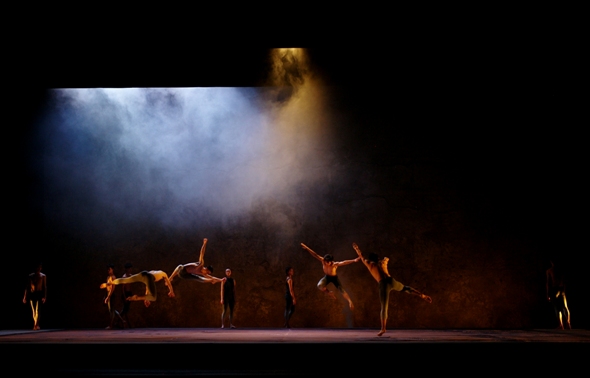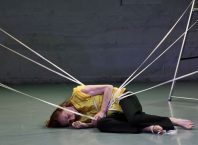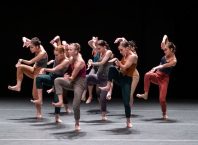Choreographer Wang Yuanyuan describes crisis and uncertainty in poetic image and movement, creating beauty from the raw materials of urban alienation, the unending struggle for survival, the unraveling of the natural environment, and despair in the face of the future. Haze, created as a response to the woes of our contemporary time, merges the spiritual and environmental haze, as the dancers leap, twirl, roll and jump through a landscape shrouded in mists, conveying at once the fragility and force of the human body and spirit.
The Beijing Dance Theater premiered Haze last night at the Israeli Opera, with performances continuing through June 8th.
Haze opens in darkness, a dark mist illuminated by points of light. As more light fills the stage, these points of light are revealed as lanterns, a symbol of past ways of life and tradition. The dance itself is not traditional, belonging firmly to the world of modern dance. It is very much an ensemble work, the dancers are all excellent, yet one does not see them as individuals in this context, but as part of a group, all confronting a similar situation and conditions. The physical conditions of the stage relate metaphorically to the economic and environmental crises of 2009: the stage is bare, fitted with a padded surface on which the dancers perform. Making their way on this terrain, the dancers rise and fall, walking, faltering, rolling, leaping and twirling through the air. Their bodies express the human vulnerability in relation to the environment, finding ways to move in the existing conditions, however difficult.
It’s a fight for survival in every way. One couple begins to move into a duet only to fall, at another point in Haze, the dark corners of the stage agitate with combat, then the dancers come into a tight cluster, competing for space.
The sound design for Haze, with compositions by Henryk Gorecki and Biosphere is strikingly beautiful and enhances the central themes, while contributing to a sense of hope and inspiration at times when the scene is at its darkest moment.
Haze comes to a conclusion confronting the unknown, as the dancers run forward to the edge of the stage, hovering on the brink of the abyss, the future. The tension and intensity of those final moments brings the work to its climax, as the dancers run back to the relative safety of the stage center, and return, time and again, to the edge, with dramatic breaks of silence and suspense in the music. The thin line dividing the present known moment from the unknown future is one that cannot be crossed, Haze concludes in moments of transcendent wonder as the dancers stand, immobile, held in the present, as the music rises around them, and flakes of snow fall all around them. Yet the scene is not one of despair, but of hope. In a landscape of uncertainty and despair, art itself, the ability to transform human suffering into art, is the source of hope.
Performances: June 6 at 20:00; June 7 at 13:00; June 8 at 21:00. Tickets are 149 – 299 NIS, to order call: 03-6927777/00.






